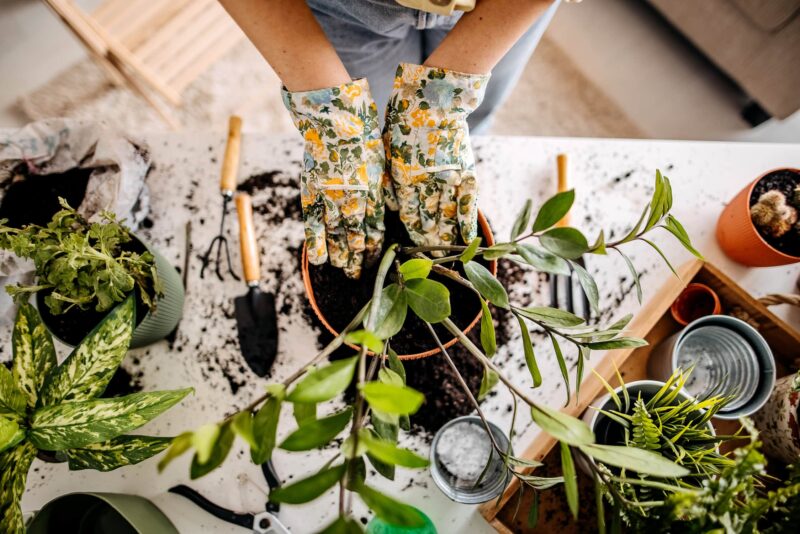Fit for a queen

Give your indoor plants the royal treatment leading into the warmer months. Words Rachel Vogan
Like your car and lawnmower, your indoor plants just love to be serviced, so make sure they pass their certificate of fitness and give a regal display by reviewing where they need some love.
Time to repot
Yes, this is the right time of year to repot and energise hard-working indoor plants. This is a job I tend to do outside, as no matter how tidy I try to be, I always seem to make a mess, with potting mix, leaves and debris going everywhere. The lawn is far more forgiving of my messes than the carpet!
Fit for purpose
Use a dedicated indoor-plant potting mix. While it might be tempting to use any old potting mix you have to hand, I always find using an indoor-planting mix gives the best results. These potting mixes are blended to provide good drainage, aerate the soil and supply plenty of plant nutrition (fertiliser).
Some specific indoor plant groups, like cacti and orchids, require more drainage than most other indoor plants, so look out for special potting mixes that have been blended just for these treasures.
Pruning roots
At transplanting time, I am a huge advocate of teasing out the root ball to have a good look at the root system. I am looking for signs of root rot (soft brown roots), insect issues and poor growth.
At this time, I prune the roots back a little, yet whenever I encourage people to do this, they look concerned, probably wondering: “Won’t that hurt the plant?” Root pruning invigorates growth, just like a haircut does for humans.
Simply avoid being too heavy-handed, and aim to trim back roots by about 20 per cent all over.
Tidy & prune
Once the roots have been taken care of, cut off any yellow or discoloured leaves. It takes effort and energy for the plant to keep supporting these leaves, so remove them. Trim back tall or spindly stems: new leaves will appear from below where the cuts are made. Thin out any overcrowded plants with multiple stems. Divide clump-forming indoor plants like peace lilies and bird of paradise plants, both of which easily handle being split up. And if you don’t have room for the new plants, gift them or sell them.
Feed & weed
Over the warmest months, indoor plants tend to grow faster, therefore using more nutrients once they are through their winter-dormant phase. Apply indoor plant food granules or pellets to all indoor plants now, unless you have fussy eaters like orchids that do not like too much food. (Look for specialised plant food for orchids.)
Weeding might sound odd, but weeds do grow on indoor plants, so keep the soil free from weeds.
Tools for the job
I find repotting, pruning and indoor plant care is always easier – and less stressful – if I am prepared and have all my tools, potting mixes, new pots and stakes all in one place. An outdoor table makes a handy workbench and is easily washed down after use.
Sharp snips or secateurs are essential, as blunt tools often tear the stems and damage the plants. While old potting mixes can be reinvigorated, I do not encourage this – instead, add the old mix to the garden or to the compost bin and refresh your indoor plants with new potting mix, as it’s packed with the nutrients and goodies that the old mix no longer has.
Fit for a Queen: Peace Lily
Queen Elizabeth II was at one with nature, and her love of the outdoors, animals and the environment was evident in numerous ways. Her Majesty loved plants and rarely missed the iconic Chelsea Flower Show. At this event she would spend hours looking at the gardens and talking to the plant breeders, garden designers and visitors. On one of my trips to the show, I was lucky enough to watch her chatting to a sweet-pea breeder for a number of minutes, while constantly smelling the scented petals to appreciate the sweet perfume. Such a gentle thing to watch.
The indoor plant that reflects the Queen would have to be the peace lily (Spathiphyllum). My thought was backed by plantsman and director of Oderings, Julian Odering. Both of us are royalists, and when I asked him which indoor plant reminded him of her, he said the peace lily. “Ditto,” I said. Julian comes from a long line of matriarchs, and he said to him the Queen was a symbol of what peace is all about. He said: “She stood for peace and kindness, she taught people how to be understanding and tolerant. Peace is goodwill, and the world needs more of it.”
So, if you are looking to salute the monarch with an indoor plant, we both agree that the peace lily would symbolise her beautifully.
